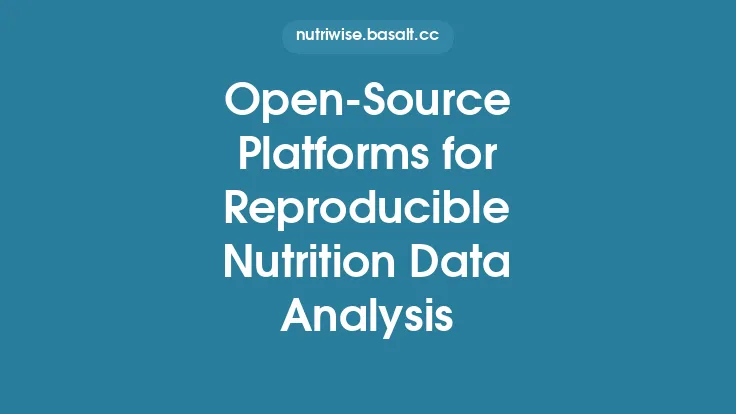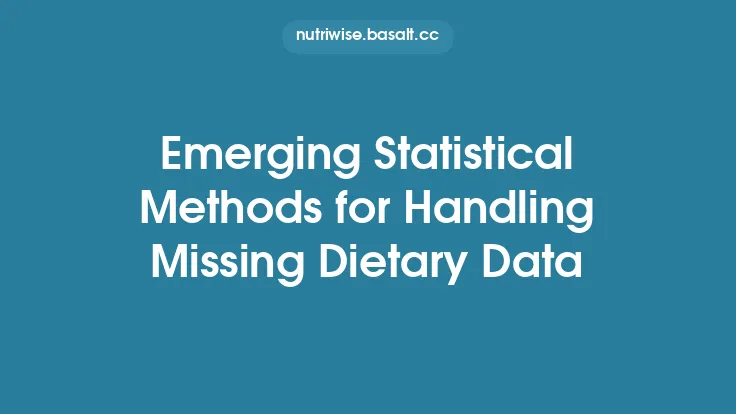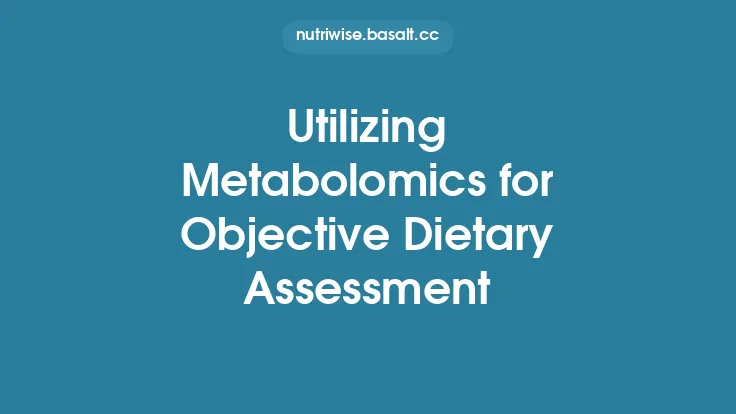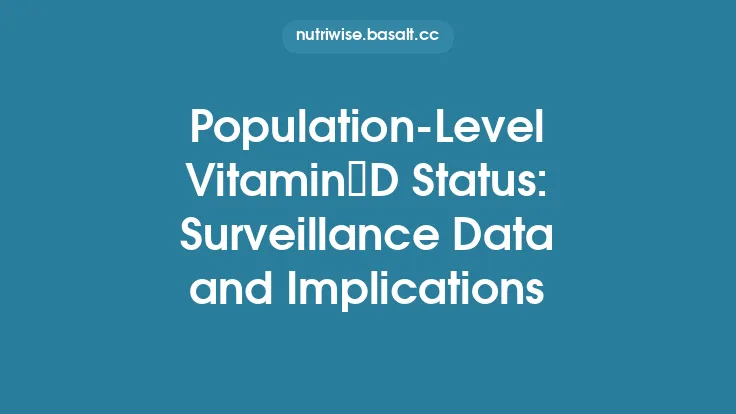Longitudinal dietary data collection sits at the core of nutrition research that seeks to understand how eating patterns evolve over time and how these changes relate to health outcomes. Unlike cross‑sectional snapshots, repeated dietary measurements capture within‑person variability, allow for the assessment of diet trajectories, and enable stronger inference about temporality. Yet, gathering high‑quality longitudinal dietary information presents a unique set of methodological challenges. Below is a comprehensive guide to best practices that researchers can adopt to maximize data integrity, minimize bias, and ensure that findings remain robust and reproducible across diverse study contexts.
Study Design Considerations
- Define Clear Objectives and Time Frames
- Articulate whether the aim is to track short‑term fluctuations (e.g., weekly) or long‑term trends (e.g., years).
- Align the frequency of dietary assessments with the biological latency of the health outcomes of interest. For chronic disease endpoints, annual or biennial assessments are often sufficient, whereas metabolic studies may require more frequent sampling.
- Select an Appropriate Cohort Structure
- Closed Cohort: All participants are enrolled at baseline and followed throughout the study. This design simplifies temporal analyses but may suffer from attrition.
- Open Cohort: New participants can be added over time, which helps maintain sample size but introduces additional heterogeneity that must be accounted for analytically.
- Determine Assessment Frequency
- Balance scientific rigor with participant burden. Empirical work suggests that three to five repeated measures over a 2‑year period capture most of the within‑person variance for macronutrients, while micronutrients often require more frequent sampling due to higher day‑to‑day variability.
- Plan for Seasonal and Cultural Influences
- Schedule assessments to span all seasons at least once, especially in regions where food availability is seasonally driven.
- Incorporate culturally specific food items and preparation methods to avoid systematic misclassification.
Participant Recruitment and Retention
- Eligibility Screening
- Ensure participants have the cognitive capacity and willingness to complete repeated dietary assessments.
- Exclude individuals with conditions that drastically alter eating patterns (e.g., bariatric surgery) unless these are central to the research question.
- Informed Consent for Ongoing Data Collection
- Clearly explain the longitudinal nature of the study, the expected number of contacts, and the type of data to be collected.
- Provide options for participants to withdraw at any point without penalty.
- Retention Strategies
- Regular Communication: Newsletters, reminder calls, and personalized feedback on dietary reports keep participants engaged.
- Incentives: Small, non‑coercive incentives (e.g., gift cards, health reports) after each completed assessment improve compliance.
- Flexible Scheduling: Offer multiple modes of data capture (online, telephone, mailed questionnaires) to accommodate varying lifestyles.
- Tracking Attrition
- Maintain a log of reasons for dropout. This information is valuable for sensitivity analyses and for refining future recruitment protocols.
Dietary Assessment Methods for Longitudinal Studies
| Method | Strengths | Limitations | Typical Use in Longitudinal Context |
|---|---|---|---|
| 24‑Hour Recalls (Multiple Pass) | Detailed intake, less reliance on memory of usual diet | High respondent burden if repeated often; requires trained interviewers | Ideal for short‑term variability studies; can be administered 2–4 times per year |
| Food Frequency Questionnaires (FFQs) | Low burden, captures habitual intake over months | Prone to systematic bias, limited portion size precision | Common for large cohorts with annual or biennial assessments |
| Dietary Records (Paper or Digital) | Precise portion and timing data | Reactivity (participants alter intake), high burden | Useful for validation sub‑studies or intensive monitoring periods |
| Repeated Short‑Form FFQs | Balance between detail and burden | May miss infrequent foods | Suitable for tracking trends in specific nutrient groups |
Best‑Practice Recommendations
- Hybrid Approaches: Combine a brief FFQ administered annually with 24‑hour recalls at quarterly intervals. This captures both habitual patterns and short‑term fluctuations.
- Standardized Reference Periods: Use consistent reference windows (e.g., “past 30 days”) across all waves to reduce measurement error.
- Portion Size Estimation: Provide participants with calibrated visual aids (photographs, portion size models) and, where feasible, digital tools that allow them to select portion images that best match their consumption.
Standardization and Calibration
- Use a Single, Validated Instrument Across Waves
- Switching instruments mid‑study introduces systematic differences that are difficult to adjust for statistically.
- Calibration Sub‑Studies
- Conduct a calibration sub‑study in a subset of participants using a gold‑standard method (e.g., weighed food records) at baseline and at least once during follow‑up.
- Derive calibration equations to correct systematic bias in the primary instrument.
- Batch Effects
- When data collection spans multiple years, ensure that any changes in questionnaire wording, coding, or interview protocols are documented.
- Apply statistical adjustments (e.g., fixed effects for data collection batch) if batch effects are detected.
Training and Quality Assurance
- Interviewer Training
- Provide comprehensive training on the multiple‑pass recall method, probing techniques, and handling ambiguous food items.
- Conduct periodic refresher sessions and inter‑rater reliability assessments.
- Standard Operating Procedures (SOPs)
- Develop SOPs for every step: participant contact, data entry, coding of foods, and handling of missing responses.
- SOPs should be version‑controlled and accessible to all team members.
- Real‑Time Data Checks
- Implement automated checks for implausible energy intakes (e.g., <500 kcal or >5,000 kcal for adults) and flag them for review.
- Use logic checks to ensure consistency (e.g., “if participant reports no dairy, dairy‑related items should be zero”).
- Audit Trails
- Maintain logs of any data edits, including who made the change, when, and why. This enhances transparency and facilitates reproducibility.
Data Management and Documentation
- Secure, Centralized Database
- Store all dietary data in a relational database with role‑based access controls.
- Back up data regularly and retain raw, unprocessed files for at least five years.
- Metadata Capture
- Record contextual information for each assessment: date, season, mode of administration (online, phone), interviewer ID, and any deviations from protocol.
- Food Composition Database (FCD) Alignment
- Link reported foods to a consistent, up‑to‑date FCD. Document the version used and any custom food codes added during the study.
- When the FCD is updated during the study, retain the original nutrient values for earlier waves to preserve comparability, or re‑code all waves using the new version and note the change.
- Version Control for Code
- Use a version‑controlled repository (e.g., Git) for all data cleaning and analysis scripts. Tag releases corresponding to each major analysis milestone.
Addressing Temporal Variability
- Seasonality Adjustment
- Include season as a covariate in statistical models or apply sinusoidal functions to model cyclical patterns.
- If assessments are not evenly distributed across seasons, consider weighting observations to reflect the underlying seasonal distribution of the target population.
- Trajectory Modeling
- Use mixed‑effects models or latent growth curve analysis to capture individual dietary trajectories over time.
- Random intercepts and slopes allow each participant to have a unique baseline intake and rate of change.
- Change‑Point Detection
- For interventions or life‑event studies, apply segmented regression to identify points where dietary patterns shift abruptly (e.g., after retirement).
Ethical and Privacy Considerations
- Data Confidentiality
- De‑identify dietary records before analysis. Remove or code any personally identifying information (e.g., names, exact addresses).
- Store linking keys (that connect identifiers to de‑identified data) separately and under strict access control.
- Informed Consent for Re‑use
- Clearly state whether data may be shared with secondary researchers or deposited in public repositories. Obtain explicit consent for such uses.
- Cultural Sensitivity
- Ensure that food lists and portion aids respect cultural dietary practices. Involve community advisory boards when working with diverse populations.
Statistical Analysis Considerations
- Handling Within‑Person Correlation
- Apply mixed‑effects models, generalized estimating equations (GEEs), or hierarchical Bayesian models to account for repeated measures within individuals.
- Energy Adjustment
- Use the residual method or nutrient density approach to control for total energy intake, which reduces confounding by overall caloric consumption.
- Imputation of Missing Dietary Data
- While emerging missing‑data methods are beyond the scope of this article, standard multiple imputation using chained equations (MICE) remains a reliable approach when missingness is at random. Ensure that the imputation model includes variables predictive of both missingness and the dietary outcome.
- Sensitivity Analyses
- Conduct analyses excluding participants with extreme energy intakes, those with high attrition, or those who changed assessment mode mid‑study to assess robustness.
- Multiple Testing
- When evaluating numerous nutrients or food groups, control the false discovery rate (e.g., Benjamini‑Hochberg) to limit type I error inflation.
Reporting Standards and Transparency
- Adhere to Established Guidelines
- Follow the STROBE‑Nutrition extension for observational studies and the CONSORT‑Nutrition guidelines for trials that incorporate dietary outcomes.
- Provide Detailed Methodological Appendices
- Include the full food list, portion size aids, coding algorithms, and calibration equations.
- Supply a flow diagram that depicts participant numbers at each assessment wave, reasons for loss, and final analytic sample.
- Share Data and Code When Feasible
- Deposit de‑identified datasets and analysis scripts in reputable repositories (e.g., Zenodo, OSF) with clear licensing.
- Include a data dictionary that maps raw variables to derived nutrient variables.
Future Directions
- Integration of Passive Data Streams: While wearable technology is outside the scope of this article, emerging research suggests that passive capture of meal timing (e.g., via smartphone logs) could complement traditional assessments, reducing recall burden.
- Adaptive Assessment Schedules: Leveraging interim data to tailor the frequency of follow‑up assessments for high‑variability participants may improve efficiency without sacrificing data quality.
- Standardized International Food Composition Databases: Continued collaboration across countries to harmonize nutrient databases will facilitate cross‑population longitudinal analyses.
By systematically applying these best practices, researchers can generate longitudinal dietary datasets that are accurate, reproducible, and richly informative. Such rigor not only strengthens the validity of nutrition‑health inferences but also builds a solid foundation for future methodological innovations.




